Third of Three Parts
In Parts One and Two of this series, we looked at the Republican “repeal and replace” effort as a case study in frustration. As we have seen, the GOP’s persistence in the face of overwhelming opposition was impressive. Yet as we have also seen, persistence does not always translate into victory.
Indeed, if we look beyond politics to a most extreme example of massed persistence—World War One’s Battle of Passchendaele, a century ago—we might gain insight into the value of adjusting one’s strategy in the face of heavy fire. And in fact, as we shall see, disaster in the short run can sometimes sow the seeds of long-run success.
In the meantime, today’s Republicans are learning to make the necessary adjustment—and of course, the only incoming rounds they face are figurative. Happily, nobody’s getting killed.
Indeed, the GOP might be getting back on the political offensive. Just on Wednesday at the White House, President Trump, flanked by U.S. Senators Tom Cotton and David Perdue, opened up a new front. Together, they announced an ambitious immigration reform bill, aimed at boosting American workers’ wages.
So yes, already, the GOP is recovering; it is launching a coordinated new offensive, aimed at a new target—it is not simply flailing away at the old target.
The Republicans Pivot Out of a Quagmire
On Capitol Hill, too, it’s evident that most Republicans have decided to “move on,” as Senate Majority Leader Mitch McConnell said in the wee hours of July 28, when the GOP healthcare bill failed. That same day, Politico quoted conservative tax activist Ryan Ellis: “I think everyone is eager to pivot [from] the health care quagmire.”
Indeed, since then, Capitol Hill Republicans have been doing just that: pivoting. An August 1 headline in The New York Times practically shouted that message: “Republicans in Congress Bypass Trump to Shore Up Health Law.” The article quoted Sen. Lamar Alexander, chairman of the Health, Education, Labor, and Pensions Committee, who had voted with McConnell, but has now adjusted himself to the new reality: “Any solution that Congress passes for a 2018 stabilization package would need to be small, bipartisan and balanced.” In other words, after Republicans threw long incomplete passes on Obamacare, they are now trying a more cautious ground game.
Needless to say, Republican lawmakers aren’t happy about this shift in the game plan. Yet they know that they still have their jobs to do for the sake of the survival of the their majority; they have to put points on the board—and that’s what solid team play is all about.
For instance, Rep. Jack Reed (R-N.Y.), who back in May voted “aye” on the House version of the GOP bill, is now seeking to hammer out a bipartisan compromise on healthcare, however temporary. Reed conceded, “Many in our party don’t want us to do this.” Indeed, the New York solon added, “Many of us still retain our philosophical opposition and substantive opposition to the Affordable Care Act.” Yet sometimes, Reed continued, one must do what’s needed, even if it’s distasteful; as he put it, “It’s clear [that what] we have to do is come together, find that common ground and govern for the American people.”
To be sure, the GOP came to this new limited-objective strategy the hard way—by taking hard hits on its original bold Obamacare plan. According to Gallup, President Trump’s approval rating fallen; it’s now just 36 percent, with 60 percent disapproving; other polls, including Rasmussen, show similar numbers.
Indeed, as polling pundit Ron Faucheux observes, the damage extends beyond the White House. According to the latest survey data, public approval of Obamacare stands at 50 percent, with just 43 percent disapproving. Meanwhile, by a 43:27 margin, people trust Democrats more than Republicans on healthcare.
So that’s a lot of damage to the GOP brand. Yet at the same time, Faucheux notes that a whopping 73 percent of Americans agree that the healthcare system “needs fundamental changes,” or “needs to be completely rebuilt.” So obviously, at least in the long term, there’s a political “market” for substantial healthcare reform.
Yet still, there’s not much of a market in the near term. We might consider, for instance, the efforts of Republican Sens. Bill Cassidy of Louisiana and Lindsey Graham of South Carolina; they are still seeking ways, even now, to “repeal and replace.” For their trouble, on August 1, they were greeted with a bearish headline in Politico: “Newest GOP health care attempt faces same tough odds.”
The two lawmakers are both savvy pols; they are acutely aware of the obstacles that past efforts have faced—both on the right as well as the left. And yet savvy awareness doesn’t necessarily mean that they have found a way to square the healthcare circle. As Politico put it:
The so-called Graham-Cassidy plan would still force deep health spending cuts, as well as set new limits that would end Medicaid’s open-ended entitlement status and threaten subsidies designed to help people afford coverage. Each element could raise objections from moderate GOP senators. That comes on top of keeping nearly all of Obamacare’s taxes, a likely deal-breaker for conservatives still intent on scrapping the entire law.
In other words, repeal-and-replacers shouldn’t get their hopes up.
In fact, by now it should be evident that if Republicans wish to score a new breakthrough against the Obamacare status quo, they will need to do more than just keep trying the same old thing. That is, they will have to think anew, and come up with something fresh. And sometimes, a look back at history can help.
The Passchendaele Precedent
It’s often been said that history is a series of case studies. And as every business-school student knows, case studies are a great way to learn. That is, the student—as well as those who are merely curious and wish to learn—can examine a given historical event and then make a judgment: Did the protagonists play it right, or did they play it wrong? How could they have done better? And perhaps more poignantly, What would I have done?
So in that spirit of inquiry, let’s venture far from health—all the way to death.
Let’s focus, in particular, on an historical event that has come to symbolize frustration, failure, and folly—even if, in the end, it also planted the seeds of future success.
The Battle of Passchendaele, also known as the Third Battle of Ypres, was fought in Belgium between July and November of 1917. On the one side were the British, the Canadians, and the French (the US had entered the war in April of that year, but our troops had not yet reached Over There), and on the other side, of course, were the Germans. The battle ended in what might be called a “catastrophic victory” for the Allies; British casualties alone are estimated at 450,000, all to gain five miles of ground. German losses, while substantial, were much less.
Ever since, Passchendaele has loomed large in British consciousness. For instance, in the new movie, Churchill, set in 1944 during World War Two, the great British prime minister is seen agonizing over the plans for D-Day. As we all know, nobody wanted to beat Hitler more than Churchill, and yet at the same time, he worried about a repeat of the slow-slog fighting in France, of the sort that had decimated Britain’s army three decades earlier. The onscreen Churchill asks, “What will our boys face in France? Another Western Front? Passchendaele?”
Just last month, the British royal family, joined by other European leaders, joined together in a special ceremony to paid tribute to the fallen. (And that sacred moment was was not spoiled by a bizarrely inappropriate attempt by pro-European Union bureaucrats to spin the battle into an endorsement of the EU, as Breitbart News’ Liam Deacon chronicled.)
The main observance was held at the Tyne Cot cemetery in Belgium. There, 11,965 British and British Commonwealth soldiers are buried—and 8,369 of them are unnamed. The graves read, simply, “A Soldier of the Great War Known Unto God.” (Elsewhere at Passchendaele, many thousands of other markers read, 1 Soldat Francais Inconnu Mort Pour La France; and Ein Unbekannter Deutscher Soldat 1914-1918.)
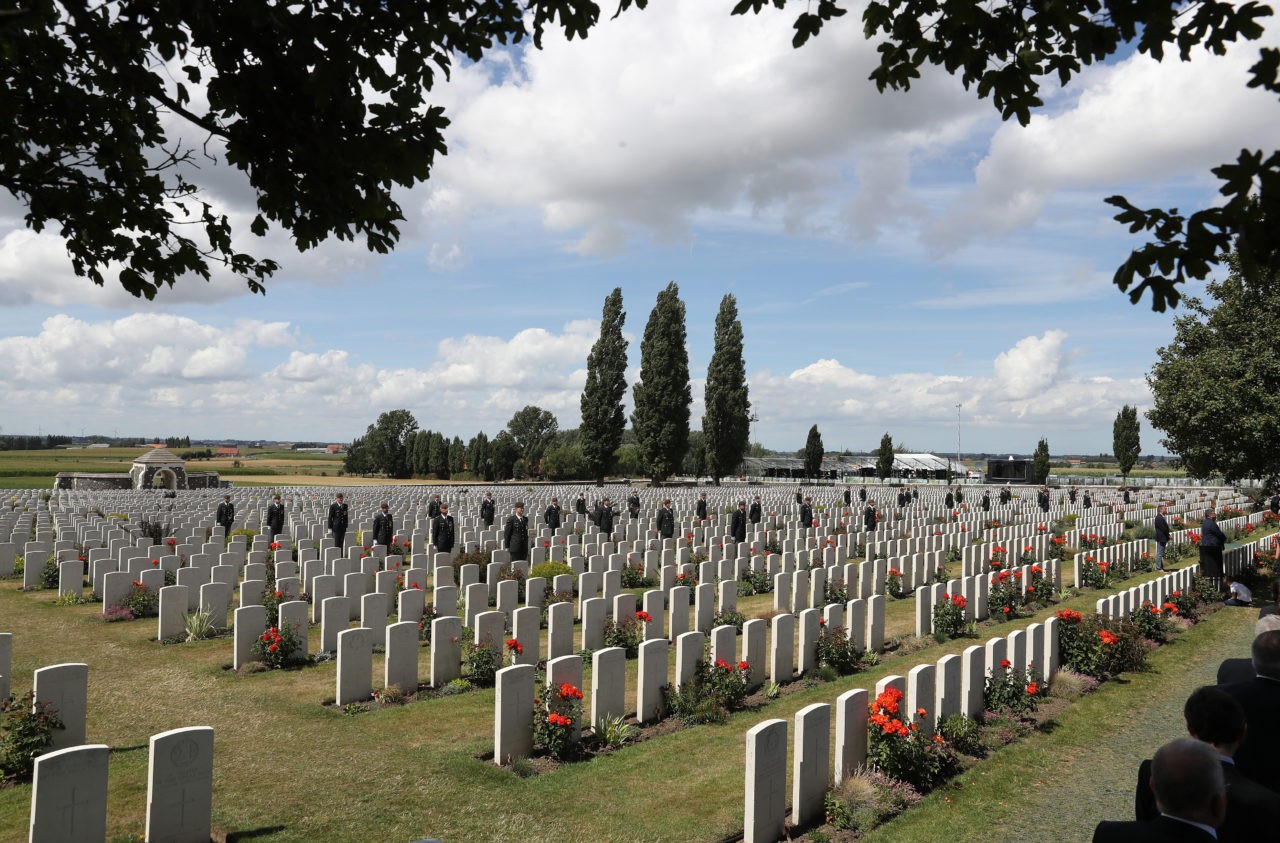
Tyne Cot Cemetery, Ypres, Belgium. (Chris Jackson/Getty Images)
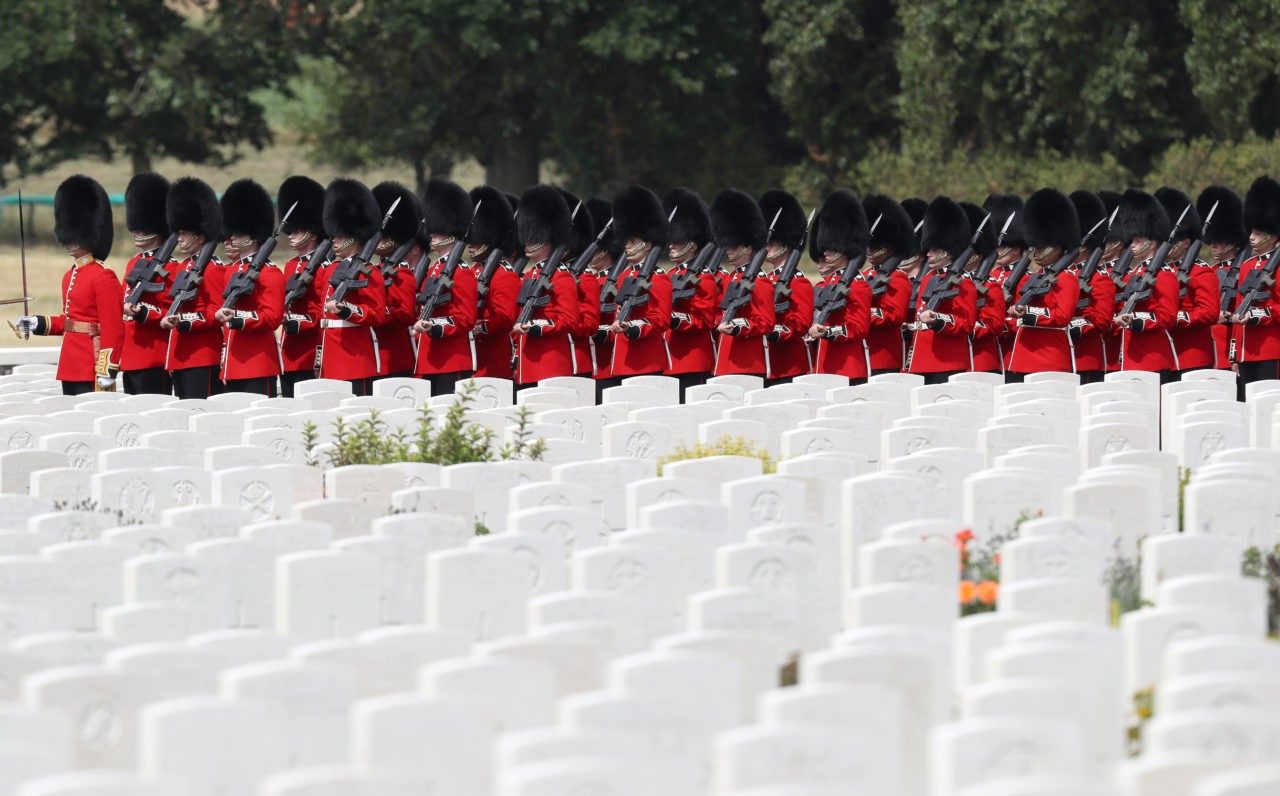
British servicemen march through Tyne Cot Cemetery on July 31, 2017, for the commemoration of the centenary of the Battle of Passchendaele. (Chris Jackson/Getty Images)
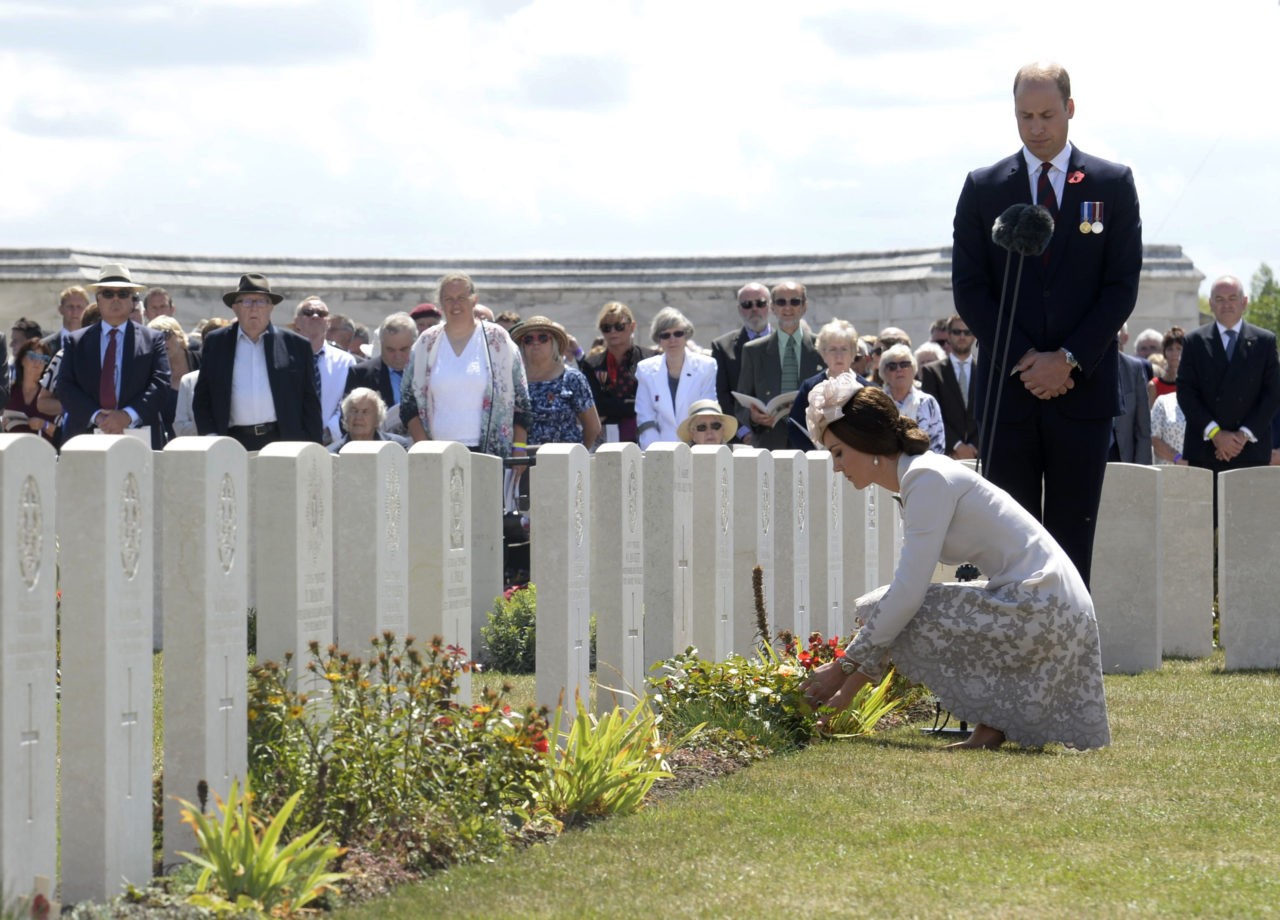
Princess Catherine, Duchess of Cambridge, and Prince William, Duke of Cambridge, lay flowers at Tyne Cot Cemetery on July 31, 2017, on the headstones of soldiers who fell in the Battle of Passchendaele. (Melanie Wenger/AFP/Getty Images)
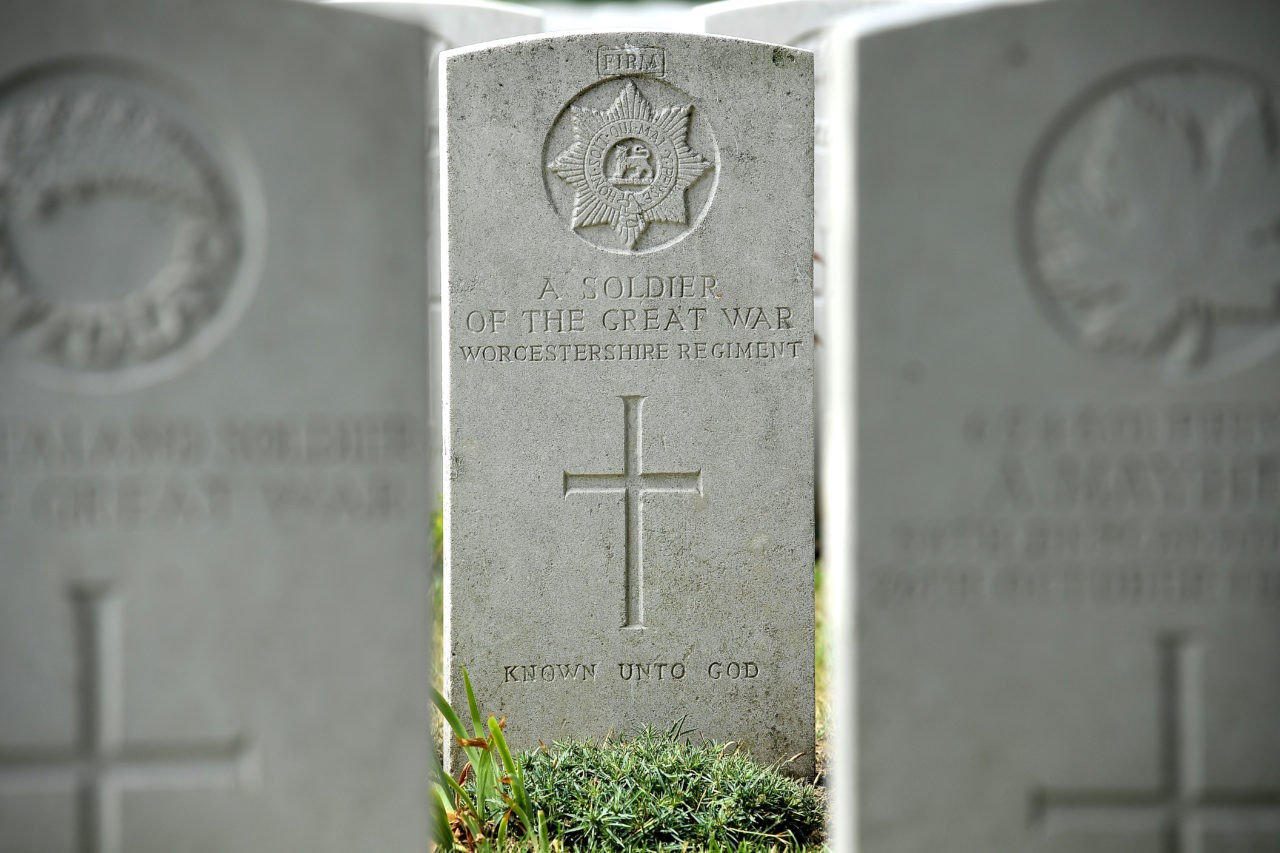
The graves of unidentified soldiers from the Battle of Passchendaele in Tyne Cot Cemetery. (Leon Neal/Getty Images)
We might ask: Why so many unknowns? The answer is two-fold: First, heavy artillery had a way of blowing men to bits; and second, heavy rains turned the battlefield into a valley of mud, such that advancing soldiers risked drowning, as well as facing enemy bullets and shrapnel. Thus many bodies simply disappeared, forever, into the murk. Indeed, inscribed on the walls of the Tyne Cot memorial are the names of another 34,959 British and Commonwealth soldiers whose remains have never found.
Okay, so now to the obvious question: Why did the battle happen? Why did the British fight so hard, and lose so much for so little—for five measly miles? Part of the reason, of course, is that war is hell.
Yet another part of the reason connects to the larger theme of this series of articles: Winning teams—and armies are indeed a kind of team—need to have the best possible strategy. If they don’t have a strong strategy, the losses can be, well, staggering; the bravest warriors can be undone by poor leadership.
A century ago, Britain had the opposite of a strong strategy. As was said of British soldiers and their generals during World War One, “They are lions, led by donkeys.” So we can see: another reason to study history is to avoid the repeat of such debacles.
More recently, right after the 2016 elections, Republicans had high hopes for repealing and replacing—for sure, at least repealing—Obamacare. There was even happy-talk of putting a repeal bill on Trump’s desk on Inauguration Day.
That high-hopes optimism, too, had historical echoes. In August 1914, at the onset of World War One, the generals—on both sides of the fighting—were optimistic that the war could be won quickly. That is, the Germans thought they’d be in Paris by Christmas, and the British and French thought they’d soon have pushed the Germans back to the Rhine and into surrender.
None of that happened, of course, and the reasons are worth pausing over.
In 1914, the generals thought that the coming war would be a struggle of maneuver; they figured it would be fought the way that Frederick the Great, or Napoleon, or the Duke of Wellington, had fought their battles. That is, victory would be the result of carefully managed maneuver that outflanked or surprised the foe—to be followed, perhaps, by a crushing infantry assault or, better yet, a dashing cavalry charge.
What the generals hadn’t grasped was that technological advances within their own militaries were negating such old-time strategies; the latest weapons were making a murderous mockery of all those ordered columns and formations. That is, the machine gun, rapid-fire artillery, and barbed wire had greatly strengthened static defense, and greatly weakened mobile offense.
The generals had all these weapons in 1914, but in advance of seeing them play out in actual large-scale combat, they had failed to appreciate their impact. It was only after a few months of fighting—and astonishing losses—that the two contesting sides learned that movement would be slow, not fast. They had to hunker down and dig in; trench warfare was the new norm.
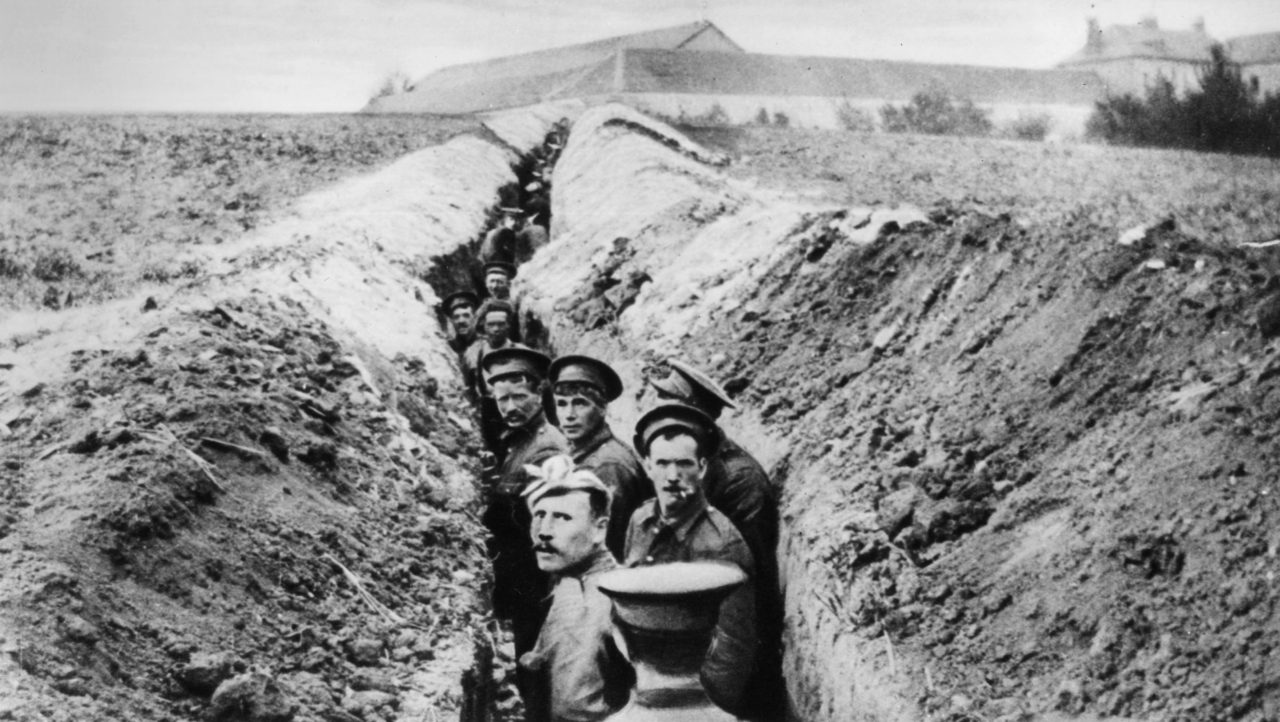
British soldiers lined up in a narrow trench during World War I, 1914. (Hulton Archive/Getty Images)
Yet even so, in spite of the bloody evidence, the generals doggedly held on to their dream of the decisive masterstroke by infantry or cavalry. And unfortunately for the British Expeditionary Force, one of the most dogged was the BEF’s commander, Field Marshal Douglas Haig.
Born in 1861, Haig had come up through the cavalry, fighting low-tech foes in India and Africa. And so by 1914, he was firmly set in his ways; he was prone to saying things like, “The machine gun is a much overrated weapon.” Such lack of situational awareness about battlefield reality might seem hard to fathom, but Haig was well insulated; he rarely visited the actual front, preferring to stay at his headquarters, studying maps and papers.
On top of that, Haig simply wasn’t all that bright. Or to put it another way, he might have made a fine head of some paper-shuffling operation, but he had been promoted too far; he was not fit to be an overall commander. (How many times in our own lives have we confronted an individual who has been elevated beyond the level of his or her competence?)
During the war, confronted with huge losses, it never occurred to him to adjust his strategy. As David Lloyd George, the British prime minister from 1916 to 1922, later recalled, “I never met anyone in a high position who seemed to me so utterly devoid of imagination.” And in his classic work, On the Psychology of Military Incompetence, the historian Norman Dixon quotes an aide to Haig as saying that the field marshal “recoiled from strategical conceptions that were not in accord with military principles.” In other words, in Haig’s mind, there was a right way to do things, period; if reality disagreed, then reality be damned—he was never going to think outside of the box.
In keeping with his rigid and rote view of military matters, Haig’s idea was to do the same thing over and over again—only each time, do it bigger. The year before Passchendaele, in 1916, Haig had ordered an offensive along the Somme River. It, too, was a “catastrophic victory,” costing the British hundreds of thousands of men for minuscule ground gains.
After that debacle, Haig should have been relieved of his command. And yet he wasn’t, because British politicians, including Lloyd George, were fearful of the public reaction if he were fired; it might seem that the whole war effort had been based on faulty premises, thus bringing the government down.
The Power of a Bad Idea
So we can step back to behold something perversely impressive: the power of a bad idea. That is, once a foolish course of action is launched, it’s oftentimes hard to pull back from it—nobody wants to admit a mistake. So that’s why dumb things have a way of rolling onward, sometimes even taking on increased momentum.
This is human nature: it’s instinctively tempting to double down, to throw good money after bad. Yes, it’s a fallacy—the fallacy of sunk costs–but it’s a common fallacy. And so it was with Haig, except that he was doubling down on blood, not just money.
After the Somme, it should have been obvious that frontal assaults against an entrenched foe just would not be effective. And yet that’s exactly what Haig planned for in 1917—another frontal assault. Lloyd George, nominally Haig’s superior, argued passionately against the plan; he had ideas of outflanking the Central Powers, perhaps by opening up a whole new warfront in the Balkans.
Yet for political reasons, Lloyd George found himself helpless to stop the plan. Haig, bolstered by other generals—this war obviously being an historic nadir of generalship—had his plan, and that was that. Years later, in his memoir, Lloyd George derided Haig’s obsession “planomania,” as a play on “monomania.”
Thus Haig’s doomed plan hulked into place: thousands of trainloads of men, ammunition, and materiel were wheeled into position. In his 1958 work, In Flanders Field: The 1917 Campaign, the historian Leon Wolff records that for the Germans, the attack would come as no surprise:
To hide the immensity of the preparations was impossible, and, in fact, the enemy was aware of the most exact details … In mid-June the Frankfurter Zeitung published a bland appraisal of British chances in the forthcoming attack at Ypres.
An exasperated Lloyd George asked in the run-up to the offensive: is it really wise to “aim our spear at the thickest part of the enemy’s armour?” The answer came back from Haig: The plan will work—the planners had promised.
The British artillery bombardment of the German positions began on July 15; in response, the Germans simply burrowed deeper into their reinforced bunkers. And also that month, the seasonal rains came sooner than expected, turning the projected battlefield into brown soup. Yet the plan had to go forward, because, well, it was the plan.

A stretcher-bearing party carrying a wounded soldier through the mud during the battle of Passchendaele. (John Warwick Brooke/Getty Images)
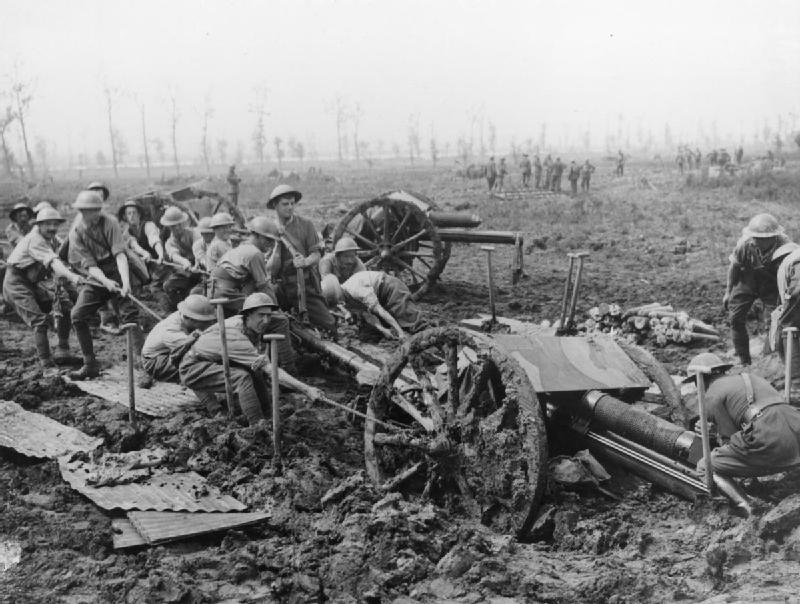
British soldiers haul an 18 pdr field gun out of the mud (John Warwick Brooke/Wikimedia Commons)
The infantry assault commenced on July 31, at which point the Germans emerged from their shelters and started firing their machine guns and mortars. The results were entirely predictable—as the enormous cemetery and memorial at Tyne Cot attests.
Haig relying on reports written by sycophants, and leading from the rear, kept up his relentless optimism. Meanwhile, at the front, shot and shell flooded the air. As one British soldier described the resulting Passchendaele battlefield:
There was not a sign of life of any sort. Not a tree, save for a few dead stumps which looked strange in the moonlight. Not a bird, not even a rat or a blade of grass. Nature was as dead as those Canadians whose bodies remained where they had fallen the previous autumn. Death was written large everywhere.

Soldiers of an Australian 4th Division field artillery brigade on a duckboard track passing through Chateau Wood, near Hooge in the Ypres salient, October 29, 1917. (Wikimedia Commons)
The deadly fighting finally petered out in November. The Germans had been hurt, too, of course, and by then they had fewer troops to spare. In addition, they now had to confront not only the American army, but also the might of America’s military-industrial complex.
In a war of attrition, the Allies would win, and so they did, a year later. And yet for their part, the British knew that they couldn’t afford any more Passchendaeles. As Lloyd George wrote:
It was obvious early in the struggle to every one who watched its course—except to those who were responsible for the strategic plan that wrought the grisly tragedy—that the goal would not be reached.
In the summarizing words of the eminent military historian A.J.P. Taylor, Passchendaele was “the blindest slaughter of a blind war.”
A Better Way
Still, some light did emerge from the dark carnage. Astute younger officers could see that the old ways were no longer working. One such was a Briton, General J.F.C. Fuller, who would later write about the battle, “To persist after the close of August in this tactically impossible battle was an inexcusable piece of pigheadedness on the part of Haig.”
Yet Fuller was more than a critic; he was also a strategic visionary. He saw, ahead of anyone else, the full potential of mobile armor—the tank—as the weapon that could break the stalemate of trench warfare. Indeed, by the end of World War One, tanks became a significant factor in the Allied victory.
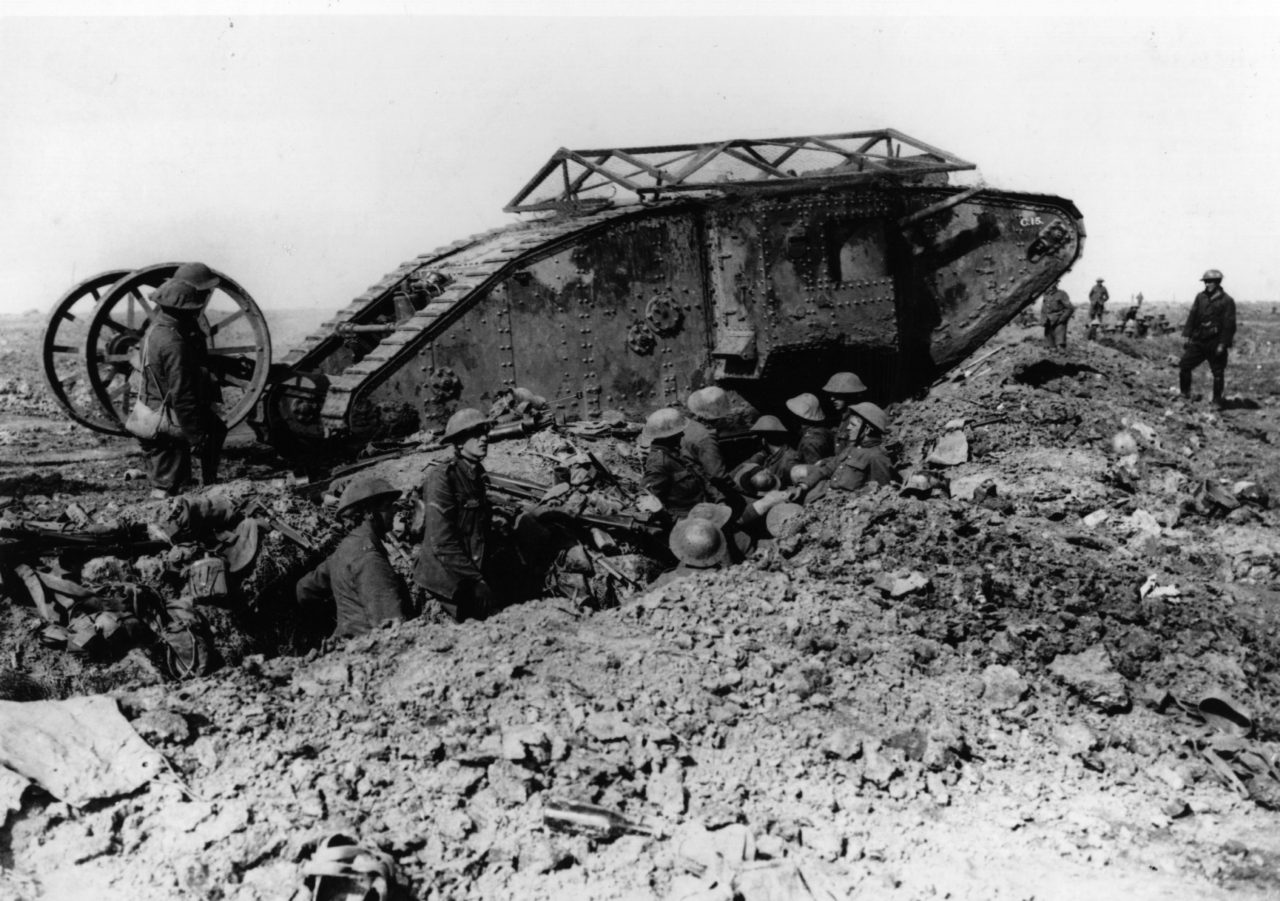
September 1917: A British tank crossing the trenches in Flanders. (Hulton Archive/Getty Images)
Indeed, Fuller can be compared to another iconoclastic military innovator of the same era, the brilliantly brash American officer, Billy Mitchell, the father of strategic military aviation. Together, Fuller and Mitchell should be seen as the geniuses who solved the puzzle of the trenches. Yes, of course, it’s sad that their great intellects had to be applied to puzzles of war, as opposed to peace. And yet at the same time, we must remember, it’s better that we have known how to win our wars, and thanks in no small part to those two geniuses, we could.
Okay, so now, from the safety and comfort of our present-day computer screens, each of us is free to draw whatever parallels we might wish between the military slog in Belgium 100 years ago, and the political slogs of our time. To be sure, the blood that’s been spilled in Washington, DC, is only metaphorical, and yet even so, the the similarities of self-destructive stubbornness are glaringly apparent. That is, once a wrong-headed strategy—frontal assaults against the enemy’s citadels—gets up a head of steam, it’s hard to stop.
So now today, finally, the fighting over healthcare has paused. Just on Wednesday, when asked about the legislative efforts on healthcare—which, as we have seen, are still sputtering along, albeit at a low level—Sen. Orrin Hatch of Utah, chairman of the powerful Finance Committee, was dismissive: “Why are they having hearings on health care? We’re onto taxation now. Health care, as far as I’m concerned, is over.”
But of course, in Washington, D.C., the political combat is never over, it only lulls. The legislative fighting on healthcare is certain to erupt again. So in anticipation of that next struggle, Republicans might look around and ask themselves: “Who’s our J.F.C. Fuller? Who’s the next Billy Mitchell? What do we have to rethink in order to win next time?”
That is, who will learn the bitter lessons of past failure—and set forth the better strategy for future victory?
The laurels of triumph await.
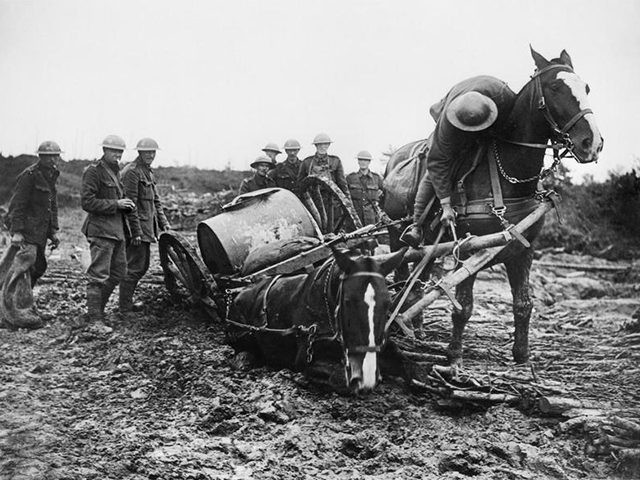
COMMENTS
Please let us know if you're having issues with commenting.